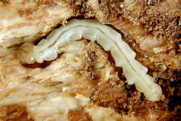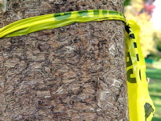An infestation has not been confirmed, but officials are scouting northeast Iowa after an Emerald Ash Borer larva was found. Iowa State University extension sent out tips today (June 5, 2009) on protecting your ash trees. See those tips at the end of the following info that was released Thursday (June 4, 2009) from the Iowa Department of Agriculture and Land Stewardship:
ELKADER – Efforts to scout portions of northeast Iowa for the presence of emerald ash borer (EAB) have intensified following the submission of an EAB larva to the Iowa Department of Natural Resources. The larva was reportedly from Clayton County, however no additional EAB larvae have been found and no signs of infestation have been spotted in the immediate area. As a result, an EAB infestation cannot yet be confirmed.

Ash borer larva/ http://www.forestryimages.org
The EAB larva was reportedly found in a small sentinel tree at the Osborne Welcome and Nature Center in Clayton County. The tree was established by the Iowa Department of Natural Resources with funding from the U.S. Forest Service.
Officials from the Iowa Department of Agriculture and Land Stewardship, DNR and Iowa State University Extension have been conducting extensive scouting of the tree and around the Osborne Center this week.
The Osborne Center is located approximately five miles south of Elkader and approximately 60 miles southwest of where an EAB infestation was confirmed in Wisconsin in early April of this year.
Additional experts are returning to the area in the upcoming weeks to place traps in the immediate and surrounding area, during the next one-two weeks, to determine if an EAB infestation is present in the area.
Officials from the Iowa Department of Agriculture and Land Stewardship, the Iowa Department of Natural Resources and Iowa State University Extension will also be hosting two public meetings on Tuesday, June 16th at the Osborne Center about this discover. The officials will meet with timber industry representatives 1:00 p.m. and then host a public meeting for residents that evening at 6:30 p.m.
EAB detection in Iowa was the result of collaborative team members looking for this pest since 2003. From visual surveys, to sentinel trees, to nursery stock inspection, to sawmill/wood processing site visits, and hundreds of educational venues [meetings, phone calls, written correspondence, media interviews, and 1-on-1 conversations], the Iowa EAB team has been working to spread the word about this invasive insect and to protect the state.
The Emerald Ash Borer (EAB) is native to the Orient, and was introduced in the United States near Detroit, Mich. in the 1990s. EAB kills all ash species by larval burrowing under the bark and eating the actively growing layers of the trees.

Emerald Ash Borer
Iowa State University Extension will issue a separate news release providing EAB management recommendations.
The metallic-green adult beetles are a half inch long, and are active from May to August. Signs of EAB infestation include one-eighth inch, D-shaped exit holes in ash tree bark and serpentine tunnels packed with sawdust under the bark. Tree symptoms of an infestation include crown thinning and dieback when first noticed, epicormic sprouting as insect damage progresses, and woodpecker feeding.
“We started our scouting efforts in the park where the larva was reportedly found and are spreading outwards. We have a five-mile radius grid that is going to be thoroughly investigated for any additional signs of EAB,” said Robin Pruisner, State Entomologist with the Iowa Department of Agriculture and Land Stewardship.
If an infestation is ultimately confirmed in Iowa, officials have a plan is in place to help stop the spread of EAB that would include a quarantine prohibiting the movement of hardwood firewood, ash nursery stock, ash timber or any other article that could spread EAB from infested areas.
Clayton County is one of the top producers of forest products in Iowa. The county has an estimated 66 million woodland trees and an estimated 6.6 million ash trees.
EAB has been killing trees of various sizes in neighborhoods and woodlands throughout the Midwest. Ash is one of the most abundant native tree species in North America, and has been heavily planted as a landscape tree in yards and other urban areas. According to the Iowa DNR, Iowa has an estimated 58 million rural ash trees and approximately 30 million more ash trees in urban areas.
The Iowa Emerald Ash Borer Team includes officials from the Iowa Department of Agriculture and Land Stewardship, Iowa State University Extension, the Iowa Department of Natural Resources, USDA Animal Plant Health Inspection Service (APHIS) and the USDA Forest Service.
The movement of firewood throughout Iowa and to other states poses the greatest threat to quickly spread EAB. Areas currently infested are under federal and state quarantines, but unknowing campers or others who transport firewood can spark an outbreak. As a result, officials are asking Iowans to not move firewood and instead buy wood where they are staying and burn it completely.
To learn more about EAB please visit www.IowaTreePests.com or for additional resources Iowans can visit http://www.iowadnr.gov/forestry/eab/index.html

Ash leaf damage/ Deb McCullough, Michigan State University
From ISU Extension:
AMES, Iowa — The presence and new discovery of emerald ash borer (EAB) in states adjacent to Iowa has increased interest in this exotic, invasive insect and what Iowans can do to protect ash trees (Fraxinus species) on their property.
ISU Extension is collaborating with Iowa state regulatory agencies and local officials to prevent introduction of EAB into Iowa and limit its spread. For a full list of EAB detection and education activities, please visit our website at: www.extension.iastate.edu/pme/EmeraldAshBorer.html
Treatment options to protect ash trees from this destructive pest are available but careful and thoughtful analysis is needed to circumvent spread of false information and excessive and needless use of insecticides. Forest, horticulture, and insect specialists with Iowa State University Extension have developed a guide that outlines your management options against EAB.
The first step for many is confirming that you do have an ash tree. Only ash trees are susceptible to EAB attack, but all species and cultivars of ash trees are at risk.
Second, is the ash tree growing vigorously and in apparent good health? Trees must be healthy and growing for treatments to be effective. Ash trees with mechanical injuries, loose bark, thin canopies, and those growing on poor sites (limited rooting area, compacted soil or other stresses) are not worth treating. If your ash tree looks healthy and is important to your landscape, then preventive treatment options may be considered.
Insecticide control measures against EAB should not be used unless you live within 15 miles of the confirmed EAB infestation. Treatment outside this risk zone is not advised. Protecting ash trees with insecticides is a long-term commitment. Most treatments will need to be reapplied annually or twice per year for an indefinite number of years to protect the tree. With that in mind, most homeowners would be ahead to remove and replace susceptible trees.
Treatment timing is critical and must be matched to insect life cycle. After mid-June treatment is not recommended because it takes time for the systemic insecticide to be distributed within the tree (from 2 – 8 weeks depending on the application method).

Ash tree damage from Emerald Ash Borer/ Mark Shour, ISU Extension
The recommended time of application is early to mid April each year. If the tree is large (more than 16” diameter), a treatment in early fall is also suggested. So the next window for treatment for trees in Iowa would be mid to late September 2009.
A new Iowa State University Extension publication, PM 2084, Emerald Ash Borer Management Options, will be available on June 12. The North Central Region Integrated Pest Management Center’s Insecticide Options for Protecting Ash Trees from EAB was issued in May 2009. Both can be found at www.extension.iastate.edu/pme/EmeraldAshBorer.html

